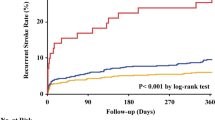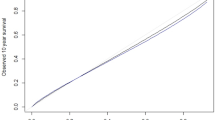Abstract
Background
Most of the models to predict prognosis after an ischemic stroke include complex mathematical equations or too many variables, making them difficult to use in the daily clinic. We want to predict disability 3 months after an ischemic stroke in an independent patient not receiving recanalization treatment within the first 24 h, using a minimum set of variables and an easy tool to facilitate its implementation. As a secondary aim, we calculated the capacity of the score to predict an excellent/devastating outcome and mortality.
Methods
Eight hundred and forty-four patients were evaluated. A multivariable ordinal logistic regression was used to obtain the score. The Modified Rankin Scale (mRS) was used to estimate disability at the third month. The results were replicated in another independent cohort (378 patients). The “polr” function of R was used to perform the regression, stratifying the sample into seven groups with different cutoffs (from mRS 0 to 6).
Results
The Parsifal score was generated with: age, previous mRS, initial NIHSS, glycemia on admission, and dyslipidemia. This score predicts disability with an accuracy of 80–76% (discovery–replication cohorts). It has an AUC of 0.86 in the discovery and replication cohort. The specificity was 90–80% (discovery–replication cohorts); while, the sensitivity was 64–74% (discovery–replication cohorts). The prediction of an excellent or devastating outcome, as well as mortality, obtained good discrimination with AUC > 0.80.
Conclusions
The Parsifal Score is a model that predicts disability at the third month, with only five variables, with good discrimination and calibration, and being replicated in an independent cohort.


Similar content being viewed by others
References
Feigin VL, Norrving B, Mensah GA (2017) Global burden of stroke. Circ Res. https://doi.org/10.1161/Circresaha.116.308413
Caro JJ, Huybrechts KF, Duchesne I (2000) Management patterns and costs of acute ischemic stroke. Stroke 31:582–590
Counsell C, Dennis M (2001) Systematic review of prognostic models in patients with acute stroke. Cerebrovasc Dis 12:159–170 (47699 [pii])
Ntaios G, Faouzi M, Ferrari J, Lang W et al (2012) An integer-based score to predict functional outcome in acute ischemic stroke: the ASTRAL score. Neurology 78:1916–1922
Lattanzi S, Bartolini M, Provinciali L, Silvestrini M (2016) Glycosylated hemoglobin and functional outcome after acute ischemic stroke. J Stroke Cerebrovasc Dis. https://doi.org/10.1016/j.jstrokecerebrovasdis.2016.03.018
Chang WH, Sohn MK, Lee J et al (2016) Predictors of functional level and quality of life at 6 months after a first-ever stroke: the KOSCO study. J Neurol 263:1166–1177. https://doi.org/10.1007/s00415-016-8119-y
Bustamante A, García-Berrocoso T, Rodriguez N et al (2016) Ischemic stroke outcome: a review of the influence of post-stroke complications within the different scenarios of stroke care. Eur J Intern Med 29:9–21. https://doi.org/10.1016/j.ejim.2015.11.030
Sim J, Teece L, Dennis MS et al (2016) Validation and recalibration of two multivariable prognostic models for survival and independence in acute stroke. PLoS ONE 11:e0153527. https://doi.org/10.1371/journal.pone.0153527
Roquer J, Rodríguez-Campello A, Jiménez-Conde J et al (2016) Sex-related differences in primary intracerebral hemorrhage. Neurology 87:257–262. https://doi.org/10.1212/WNL.0000000000002792
Johnston KC, Wagner DP, Wang XQ et al (2007) Validation of an acute ischemic stroke model: does diffusion-weighted imaging lesion volume offer a clinically significant improvement in prediction of outcome? Stroke 38:1820–1825. https://doi.org/10.1161/STROKEAHA.106.479154
Chang W, Cheng J, Allaire JJ, Xie Y, McPherson J (2016) shiny: web application framework for R [Computer software]. Retrieved from https://CRAN.R-project.org/package=shiny
Bursac Z, Gauss CH, Williams DK, Hosmer DW (2008) Purposeful selection of variables in logistic regression. Source Code Biol Med 3:1–8. https://doi.org/10.1186/1751-0473-3-17
Bennett DA (2001) How can I deal with missing data in my study? Aust N Z J Public Health 25:464–469. https://doi.org/10.1111/j.1467-842X.2001.tb00294.x
Battaggia A, Scalisi A, Donzelli A (2018) The systematic review of randomized controlled trials of PCSK9 antibodies challenges their “efficacy breakthrough” and the “lower, the better” theory. Curr Med Res Opin 34:1725–1730. https://doi.org/10.1080/03007995.2018.1428188
Yaghi S, Elkind MSV (2016) Lipid control and beyond: current and future indications for statin therapy in stroke. Curr Treat Options Cardiovasc Med 18:1–15. https://doi.org/10.1007/s11936-016-0448-8
Gladman JRF, Harwood DMJ, Barer DH (1992) Predicting the outcome of acute stroke: prospective evaluation of five multivariate models and comparison with simple methods. J Neurol Neurosurg Psychiatry 55:347–351
Weimar C, Ziegler A, König IR, Diener H-C (2002) Predicting functional outcome and survival after acute ischemic stroke. J Neurol 249:888–895. https://doi.org/10.1007/s00415-002-0755-8
Weimar C, König IR, Kraywinkel K et al (2004) Age and National Institutes of Health stroke scale score within 6 hours after onset are accurate predictors of outcome after cerebral ischemia: development and external validation of prognostic models. Stroke 35:158–162. https://doi.org/10.1161/01.STR.0000106761.94985.8B
Reid JM, Gubitz GJ, Dai D et al (2010) Predicting functional outcome after stroke by modelling baseline clinical and CT variables. Age Ageing 39:360–366. https://doi.org/10.1093/ageing/afq027
Stinear C (2010) Prediction of recovery of motor function after stroke. Lancet Neurol 9:1228–1232. https://doi.org/10.1016/S1474-4422(10)70247-7
Muscari A, Puddu GM, Santoro N, Zoli M (2011) A simple scoring system for outcome prediction of ischemic stroke. Acta Neurol Scand 124:334–342. https://doi.org/10.1111/j.1600-0404.2010.01479.x
Wang W-YY, Sang W-WW, Jin D et al (2017) The prognostic value of the iScore, the PLAN Score, and the ASTRAL Score in acute ischemic stroke. J Stroke Cerebrovasc Dis 26:4–9. https://doi.org/10.1016/j.jstrokecerebrovasdis.2017.01.013
de Ridder IR, Dijkland SA, Scheele M et al (2018) Development and validation of the Dutch Stroke Score for predicting disability and functional outcome after ischemic stroke: a tool to support efficient discharge planning. Eur stroke J 3:165–173. https://doi.org/10.1177/2396987318754591
Halligan S, Altman DG, Mallett S (2015) Disadvantages of using the area under the receiver operating characteristic curve to assess imaging tests: a discussion and proposal for an alternative approach. Eur Radiol 25:932–939. https://doi.org/10.1007/s00330-014-3487-0
Parikh CR, Thiessen-Philbrook H (2014) Key concepts and limitations of statistical methods for evaluating biomarkers of kidney disease. J Am Soc Nephrol 25:1621–1629. https://doi.org/10.1681/ASN.2013121300
Yperman J, Becker T, Valkenborg D et al (2020) Machine learning analysis of motor evoked potential time series to predict disability progression in multiple sclerosis. BMC Neurol 20:1–15. https://doi.org/10.1186/s12883-020-01672-w
Acknowledgements
This work was supported by a grant from Instituto de Salud Carlos III (PI 11/0176), Generación Project, Maestro Project, INVICTUS + network, Epigenesis Project (Marató de TV3) and FEDER funds. E. Muiño is supported by a Río Hortega Contract (CM18/00198) from Instituto de Salud Carlos III. J. Cárcel-Márquez is supported by AGAUR Contract (agència de gestió d'ajuts universitaris i de recerca; FI_DGR 2019, grant number 2019_FI_B 00853). A. Bustamante is supported by a Juan Rodés Research Contract (JR16/00008) from Instituto de Salud Carlos III.
Author information
Authors and Affiliations
Corresponding author
Ethics declarations
Conflicts of interest
The authors declare that they have no conflict of interest.
Ethical standard statement
This study was approved by the local ethics committee and an informed consent document about the registry was signed by every patient or their relatives (code 2005/2088/I and 2008/3083/I for Discovery cohort, PR(AG)157/2011 for replication cohort).
Electronic supplementary material
Below is the link to the electronic supplementary material.
Rights and permissions
About this article
Cite this article
Muiño, E., Bustamante, A., Rodriguez-Campello, A. et al. A parsimonious score with a free web tool for predicting disability after an ischemic stroke: the Parsifal Score. J Neurol 267, 2871–2880 (2020). https://doi.org/10.1007/s00415-020-09914-0
Received:
Revised:
Accepted:
Published:
Issue Date:
DOI: https://doi.org/10.1007/s00415-020-09914-0




